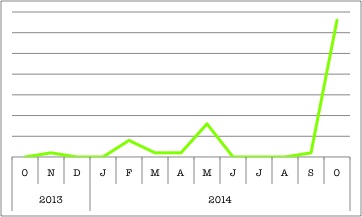The Flying Dutchman. A 4×4. Animal style fries, well done. If you know the lingo, In-N-Out’s “secret” menu has enough delicious goodies to satisfy everyone’s tastes. Personally, I’d never order the “Wish Burger” (as in, “I wish there were meat in here”), but for some people, the whole salad-in-a-bun concept suits them just fine. In the same way, there’s a select group of proteins that require a special amino acid—one that’s encoded in an entirely different way than all the rest.

Want a special amino acid? Just like when ordering Jamba Juice’s off-menu flavors (“White Gummi Bear”!!!), you have to know the secret code… [Image: David O’Hare, CC-BY SA 2.0)
Known as the “21st amino acid”, selenocysteine is encoded by the codon UGA. Yes, that’s right—the stop codon. UGA normally terminates translation, marking the end of a newly synthesized protein. But in this case, when UGA is paired with a specific stem loop structure (known as a “Sec insertion sequence element”) in the 3’ UTR of the gene, a selenocysteine is inserted instead, and translation continues.1 As an analog of cysteine (a much more common amino acid), selenocysteine is identical except that a selenium atom has replaced the usual sulfur. In the absence of selenium (and thus selenocysteine), selenoprotein translation just stops at the UGA, resulting in a truncated, non-functional enzyme.

The largest commercial use of selenium (accounting for 50% of consumption) is in glassmaking, as a compound that adds red coloring. For a prime example, check out this awesome Chihuly glass exhibit! [Image: 4johnny5, CC BY 2.0]
There are exactly 25 human selenoproteins (proteins that require selenocysteine), thereby making selenium an essential trace element.2 Most of our selenium comes from eating foods that had their own selenoproteins, like eggs and fish.3 Other dietary sources include corn, garlic, onion, broccoli, and brazil nuts.4 However, there’s a lot of variation in selenium intake; plants absorb selenium through the soil, which varies in selenium content depending on geography.5 In fact, people in Finland eat 10x less selenium than people in Venezuala!6 This is less than ideal, since selenium deficiency, especially during development, can lead to mental disorders and epilepsy.7 Clinical trials also suggest that selenium (which has known antioxidant properties) suppresses genetic damage, and can even be protective against certain carcinomas.8 Unsurprisingly, selenium is already included in all baby formulas, and in Finland, selenium has been added to the soil via fertilizers!9

Courtesy of a Peruvian salesman, some shelled brazil nuts! Apparently these can be super-rich in selenium. [Image: USDA Forest Service Alaska Region, CC BY 2.0)
The first selenoproteins were discovered in 1973, but many remain uncharacterized. In general, because of selenium’s antioxidant properties (and prime location in selenoprotein’s active sites), selenoproteins have been associated with redox regulation. Selenoprotein T, the current Gene-of-the-Week, is no exception. While one of its functions is redox regulation, it’s also been implicated in such diverse roles as cell adhesion, calcium homeostasis, neuroendocrine secretion, and glucose homeostasis.1011 Exact mechanisms remain unclear, but selenoprotein T appears to be regulated by PACAP, a peptide that’s also ubiquitously expressed and important for a variety of biological functions. All in all, not much is known about this mystery selenoprotein.

For some reason, the three most recent studies that discuss Selenoprotein T and selenium deficiency were all conducted in chickens. (It turns out that chickens really need their selenium!) Could selenium-fortified chickens be on the horizon
We might not know much about selenoproteins, but we do know that they’re important.
Which makes selenium important.
Which makes people worry about their diets.
But don’t worry—researchers are already proposing to use selenium-containing yeasts to increase our dietary intake.12 Who knows, maybe there’ll be selenium-fortified bread in our future… or maybe even some selenium beer! In the meantime, go ahead and enjoy your brazil nuts.
* Speaking of “secret” amino acids… did you know there’s another one called selenomethionine?? It’s less interesting than selenocysteine, in that it contains selenium, but just inserts randomly into places where methionine would be. And oh yeah, don’t forget amino acids #22 & 23: pyrrolysine and N-formylmethionine.
REFERENCES:
- Mariotti et al. (2012) Composition and evolution of the vertebrate and mammalian selnoproteomes. PLoS ONE 7(3):e33066. [↩]
- Kieliszek and Blazejak. (2013) Selenium: significance, and outlook for supplementation. Nutrition 29:713-718. [↩]
- Kieliszek and Blazejak. (2013) Selenium: significance, and outlook for supplementation. Nutrition 29:713-718. [↩]
- Kieliszek and Blazejak. (2013) Selenium: significance, and outlook for supplementation. Nutrition 29:713-718. [↩]
- Kieliszek and Blazejak. (2013) Selenium: significance, and outlook for supplementation. Nutrition 29:713-718. [↩]
- Kieliszek and Blazejak. (2013) Selenium: significance, and outlook for supplementation. Nutrition 29:713-718. [↩]
- Tanguy et al. (2011) The PACAP-regulated gene selenoprotein T is highly induced in nervous, endocrine, and metabolic tissues during ontogenetic and regenerative processes. [↩]
- Kieliszek and Blazejak. (2013) Selenium: significance, and outlook for supplementation. Nutrition 29:713-718. [↩]
- Kieliszek and Blazejak. (2013) Selenium: significance, and outlook for supplementation. Nutrition 29:713-718. [↩]
- You et al. (2014) Prediction of Selenoprotein T structure and its response to selenium deficiency in chicken immune organs. Biol Trace Elem Res 160:222-231. [↩]
- Prevost et al. (2013) The PACAP-regulated gene selenoprotein T is abundantly expressed in mouse and human β-cells and its targeted inactivation impairs glucose tolerance. Endocrinology 154(10):3796-3806. [↩]
- Kieliszek and Blazejak. (2013) Selenium: significance, and outlook for supplementation. Nutrition 29:713-718. [↩]

Trackbacks/Pingbacks